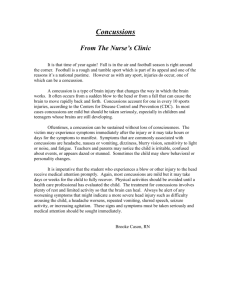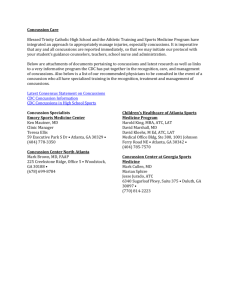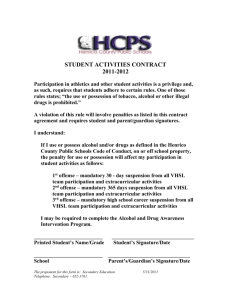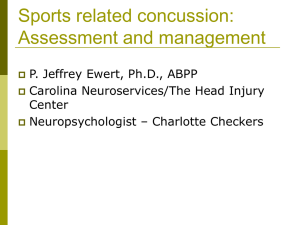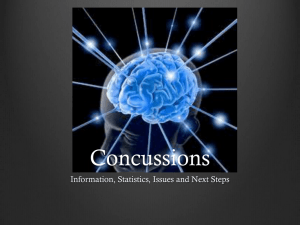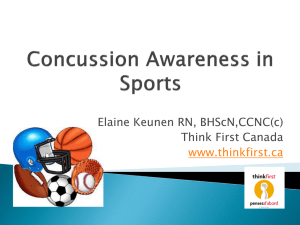Concussions - reader2010
advertisement
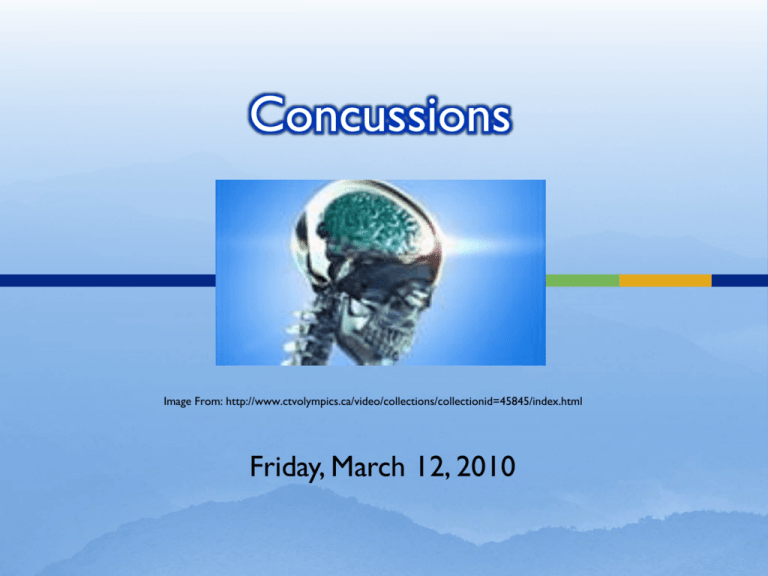
Concussions Image From: http://www.ctvolympics.ca/video/collections/collectionid=45845/index.html Friday, March 12, 2010 What is a concussion? “Concussion may be caused either by a direct blow to the head, face, neck or else where on the body with an ‘impulsive’ force transmitted to the head.” (Play it Cool, 2010) Concussion Symptoms From the “Play it Cool” website “Concussion typically results in the rapid onset of short-lived impairment of neurologic function that resolves spontaneously.” Examples include: Nausea, double or fuzzy vision, sensitivity to light or noise, headache, feeling sluggish, feeling foggy or groggy, concentration or memory problems, confusion My Concussion History Tuesday, February, 26, 2010 Running an on-ice practice with the varsity girls hockey team, I collided with a student & hit my head on the ice (I was wearing a helmet) Symptoms: Dizzy Felt sick to my stomach Was spacey (a.k.a. – I was out of it) Headaches for about 2 weeks My Concussion History Tuesday, March 2, 2010 Hit in the back of the head with a hard rubber ball while playing European handball with the grade 12 co-ed class Symptoms: Instant headache (has not gone away) I was totally out of it Vision in left eye was blurry, out of focus, & I was seeing lines across my eye Concussions in the news The Globe & Mail (Tuesday, March 9, 2010) The Globe & Mail (Monday, March 8, 2010) Concussion effects linger for decades, study finds Concussions can’t be eliminated completely National Post (Thursday, February 25, 2010) NFL combine puts more emphasis on concussions Curriculum Link Grade 11 University Biology (SBI3U) Strand E. Animals: Structure & Function Specific Expectation: E1.1: Evaluate the importance of various technologies, including Canadian contributions, to our understanding of internal body systems ( e.g., ... Nuclear magnetic resonance [NMR] imaging can be used to diagnose injuries ...) Curriculum Link Grade 11 University Physics (SPH3U) Strand C: Forces Specific Expectation C 1.2: Evaluate the impact on society and the environment of technologies that use principles of force Relevance to students You can suffer a concussion while engaging in sports such as hockey, football, soccer, boxing and other sports, or leisure activities, for example tobogganing In the past 2.5 years, 200 concussions have been reported among NHL players (Globe Sports, 2010, Section R7) “Close to 10% of minor hockey players suffer concussions each year” (The Globe & Mail: Concussion effects linger for decades, 2010) “According to the Centers for Disease Control and Prevention, between 1.4 and 3.6 million sports and recreation-related concussions occur each year, with the majority happening at the high school level.” (Science Daily, 2007) Scanning Technology “Traditional brain scanning techniques such as MRI and CT are helpful in viewing changes to the brain anatomy in more severe cases, but cannot identify subtle brain-related changes that are believed to occur on a metabolic rather than an anatomic level.” (Science Daily, 2007) ImPACT Test Immediate Post-Concussion Assessment & Cognitive Testing Used a baseline and for post-concussion comparison) Measures multiple aspects of cognitive functioning including neurological tests that look at word discrimination, X’s & O’s, colour match, symbol matching, visual attention span (http://www.impacttest.com/) New Helmet Technology The Messier Project “... is an all-encompassing grassroots and educational initiative which aims to change priorities in the sport by encouraging athletes to play smart and choose the best protective equipment.” (http://www.cascadeicehockey.com/the-project.html) The Technology “Seven Technology is tuned to absorb impact using lateral displacement, providing the protection of two helmets in the space of one – one for catastrophic hits and one for concussions.” (http://www.cascadeicehockey.com/the-technology.html) The Helmet References CBC News – Health (2010). Concussions should be termed brain injury: study. Retrieved March 9, 2010 from http://www.cbc.ca/health/story/2010/01/18/concussion-childrenbrain-injury.html The Globe & Mail (2010). Concussion effects linger for decades, study finds. Retrieved March 9, 2010 from http://www.theglobeandmail.com/news/national/concussion-effectslinger-for-decades-study-finds/article1494423/ The Globe & Mail (2010). Concussions can’t be eliminated completely. Retrieved Tuesday, March 9, 2010 from http://www.theglobeandmail.com/sports/hockey/concussions-cantbe-eliminated-completely/article1494155/ ImPACT Test (2010). Retrieved March 10, 2010 from http://www.impacttest.com/ References National Post (2010). NFL combine puts more emphasis on concussions. Retrieved Tuesday, March 9, 2010 from http://www.nationalpost.com/sports/story.html?id=2613215 The Messier Project (2010). Retrieved Tuesday, March 10, 2010 from http://www.cascadeicehockey.com/ Play it Cool – Keeping Hockey Safe (2010). Retrieved March 10, 2010 from http://playitcoolhockey.com/home/index.html Shoalts, D. (2010, March 9). NHL focuses attention on shoulder hits to head. The Globe & Mail, pp. R7. Science Daily (2007). Sports concussions research using Functional MRI provides insight for safe return to play. Retrieved March 9, 2010 from http://www.sciencedaily.com/releases/2007/08/070806114252.htm
